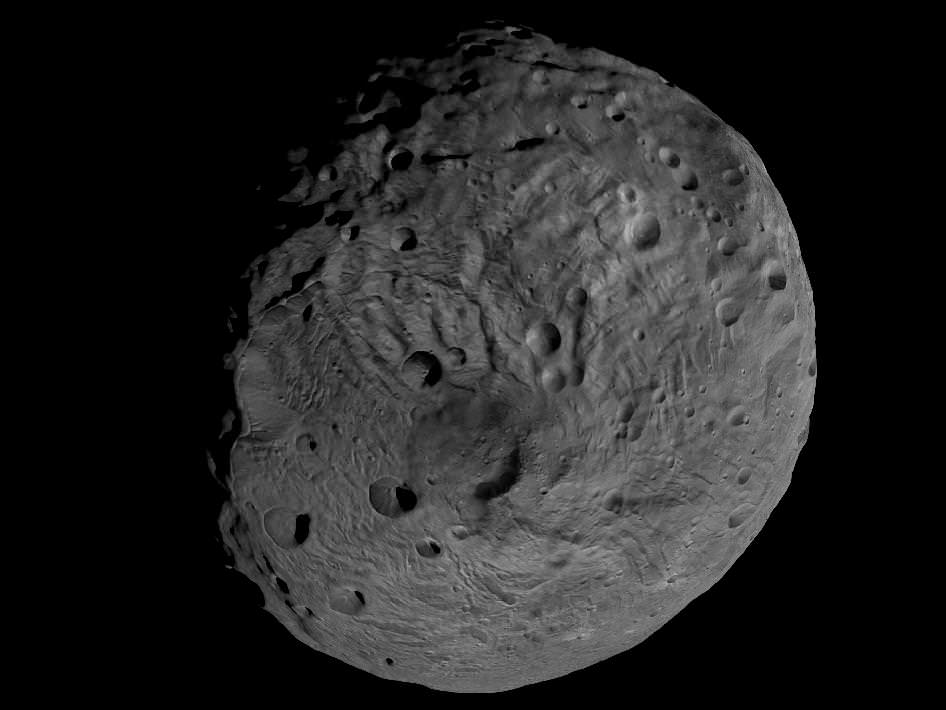Take us into orbit Mr. Sulu!
The Dawn science team has released two spectacular rotation movies of the entire globe of the giant asteroid Vesta. The flyover videos give the distinct impression that you are standing on the bridge of the Starship Enterprise and gazing at the view screen as the ship enters orbit about a new planet for the first time and are about to begin an exciting new journey of exploration and discovery of the body you’re looking at below.
Thanks to NASA, DLR, ASI and Dawn’s international science and engineering team, we can all join the away team on the expedition to unveil Vesta’s alluring secrets.
Click the start button and watch protoplanet Vesta’s striking surface moving beneath from the perspective of Dawn flying above – in the initial survey orbit at an altitude of 2700 kilometers (1700 miles). Vesta is the second most massive object in the main asteroid belt and Dawn’s first scientific conquest.
Another video below was compiled from images taken earlier on July 24, 2011 from a higher altitude after Dawn first achieved orbit about Vesta and revealed that the northern and southern hemispheres are totally different.
The array of images in the videos was snapped by Dawn’s framing camera which was provided by the German Aerospace Center (DLR). The team then created a shape model from the images, according to Dr. Carol Raymond, Dawn’s Deputy Principal Investigator from NASA’s Jet Propulsion Laboratory in Pasadena, Calif.
The shape model will aid in studying Vesta’s strikingly diverse features of mountains, ridges, valley’s, scarps, cliffs, grooves, craters, even a ‘snowman’ and much more.
Notice that not all of Vesta is illuminated – because it’s northern winter at the asteroid. Vesta has seasons like Earth and the northern polar region in now in perpetual darkness. Data is collected over the day side and radioed back to Earth over the night side.
“On Vesta right now, the southern hemisphere is facing the sun, so everywhere between about 52 degrees north latitude and the north pole is in a long night,” says Dr. Rayman, Dawn’s Chief Engineer from JPL. “That ten percent of the surface is presently impossible to see. Because Dawn will stay in orbit around Vesta as together they travel around the sun, in 2012 it will be able to see some of this hidden scenery as the seasons advance.”
Another movie highlight is a thorough look at the gigantic south pole impact basin. The circular feature is several hundred miles wide and may have been created by a cosmic collision eons ago that excavated massive quantities of material and basically left Vesta lacking a south pole.
[/caption]
The massive feature was discovered in images taken by the Hubble Space Telescope several years ago and mission scientists have been eager to study it up close in a way that’s only possible from orbit. Dawn’s three science instruments will investigate the south pole depression in detail by collecting high resolution images and spectra which may reveal the interior composition of Vesta.
Dawn entered the survey orbit on Aug. 11 and completed seven revolutions of 69 hours each on Sept. 1. It transmitted more than 2,800 pictures from the DLR framing camera covering the entire illuminated surface and also collected over three million visible and infrared spectra from the VIR spectrometer – provided by ASI, the Italian Space Agency. This results exceeded the mission objectives.
The Dawn spacecraft is now spiraling down closer using its ion propulsion system to the next mapping orbit – known as HAMO – four times closer than the survey orbit and only some 680 km (420 miles) above the surface.
Read Ken’s continuing features about Dawn
3 D Alien Snowman Graces Vesta
NASA Unveils Thrilling First Full Frame Images of Vesta from Dawn
Dawn Spirals Down Closer to Vesta’s South Pole Impact Basin
First Ever Vesta Vistas from Orbit – in 2D and 3D
Dawn Exceeds Wildest Expectations as First Ever Spacecraft to Orbit a Protoplanet – Vesta
Dawn Closing in on Asteroid Vesta as Views Exceed Hubble
Dawn Begins Approach to Asteroid Vesta and Snaps First Images
Revolutionary Dawn Closing in on Asteroid Vesta with Opened Eyes


It looks like a giant walnut!
there are 5953.5 days in a vestan year.
dizzying eh?
what’s the escape velocity at the equator?
i bet you could jump off the thing.
Vesta’a escape velocity is slightly above Mach 1 at 792 mph (1,275Km/h).
I would just like to point out that the camera was NOT provided by DLR. It was built by MPS, and is operated by MPS.